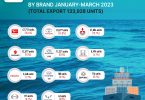 JAKARTA—The automotive industry is one of the priority sectors to be developed. The automotive industry also plays a major role in boosting national economic growth. Now Indonesia is still the main destination for investment in the automotive industry sector.
JAKARTA—The automotive industry is one of the priority sectors to be developed. The automotive industry also plays a major role in boosting national economic growth. Now Indonesia is still the main destination for investment in the automotive industry sector.
“Indonesia is now more competitive for the automotive industry,” said President Joko Widodo at the inauguration of PT Mitsubishi Motor Krama Yudha Indonesia (MMKI) at Greenland International Center (GCII), Cikarang, Bekasi (West Java), Tuesday, 25 April 2017.
The large domestic automotive market adds more appeal to investors investing in Indonesia. The President also asked all stakeholders to facilitate the permit process for investment. “With so many investments, more jobs are added. The new factory of MMKI creates jobs for 3,000 workers,” said the President.
The President hopes that all automotive industries in Indonesia will not only meet the domestic market but also be able to export.
The Minister of Industry Airlangga Hartarto said that at present the car market in Indonesia reaches 1.1 million units per year, with exports of 200 thousand units per year. “The automotive industry creates jobs for three million workers in Indonesia. We are targeting total national production for four-wheel vehicles at 2.5 million units by 2020, “he said.
The investment of MMKI creates a significant impact on the growth of the automotive industry in Indonesia, and it also creates a major contribution to the national economy. “In this area alone there are three major automotive industries, namely Mitsubishi Motors, Suzuki, and Wuling,” he said.
In 2016, the contribution of the transportation equipment industry subsector (including the automotive industry) to the gross domestic product (GDP) of the non-oil industry sector reached 10.47 percent. It was the third largest after the food and beverage industry subsector (32.84 percent) and the industrial subsector of metals, computers, electronics, optics and electrical equipment (10.71 percent).
The total investment of MMKI is IDR 7.5 trillion. The new plant sits on 51 hectares with a capacity of 160 thousand units per year, and will increase to 240 thousand per year. The plant involves 212 local tier-1 and 369 tier-2 suppliers. “This will enhance the competitiveness of the automotive industry and the domestic component,” the minister said. (*)








